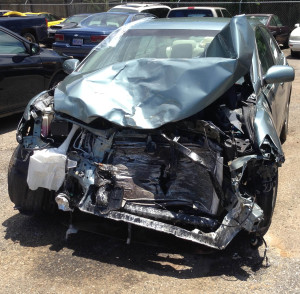 I’m writing this the day before the two-year anniversary of my car wreck. Looking back at last year’s reflections, “It’s All Grace,” one thing hasn’t changed: I still don’t want to dwell on the accident itself. I still get a little creeped out when I hear or see an ambulance. Have I become a more careful driver? Sure. Do I want to watch the video of the wreck (compliments of the video cam on the front of the ambulance)? No. I have a copy of the DVD. It’s in a thick file folder with all the paperwork from Sacred Heart Trauma Center in Pensacola, Florida. I pretty much have the rest of the contents of that folder memorized. It was such a relief when the insurance and medical bills were finally all settled, over a year after the wreck. There are lots of other folders in the same drawer—4 different surgeons, 2 different physical therapy centers, home health services and equipment, etc. But those are just the details.
I’m writing this the day before the two-year anniversary of my car wreck. Looking back at last year’s reflections, “It’s All Grace,” one thing hasn’t changed: I still don’t want to dwell on the accident itself. I still get a little creeped out when I hear or see an ambulance. Have I become a more careful driver? Sure. Do I want to watch the video of the wreck (compliments of the video cam on the front of the ambulance)? No. I have a copy of the DVD. It’s in a thick file folder with all the paperwork from Sacred Heart Trauma Center in Pensacola, Florida. I pretty much have the rest of the contents of that folder memorized. It was such a relief when the insurance and medical bills were finally all settled, over a year after the wreck. There are lots of other folders in the same drawer—4 different surgeons, 2 different physical therapy centers, home health services and equipment, etc. But those are just the details.
What I’m thinking about today is my life moving forward. Just over a month ago a friend had a terrible accident with a lawnmower and lost her big toe and a lot of skin, tissue and cartilage on her left foot. I spent some time with her in the hospital during the two weeks in which she had 7 surgeries. She will have several more in the coming weeks and months. She’s anxious about the future—what to expect looking forward. She’s been told that it will be a year before she reaches her “new normal.”
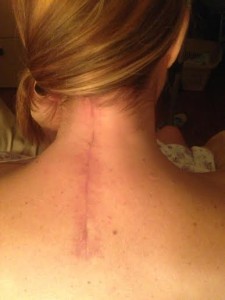 That got me to thinking about what my “new normal” looks like. I know that people mean well when they see me at church or elsewhere and say things like, “You look wonderful!” or “I’m so glad to see you back to normal.” I guess I look “normal” because my injuries—unlike my friend who lost a toe—aren’t so visible on the outside. You can’t see the plates and nails and screws that are holding my neck and right leg and ankle together. You can’t see the bumpy line of scar tissue where staples once repaired the gash on top of my head. You can’t see my neck zipper because of my long hair. And of course you can’t see the aches, pains and stiffness. But I can feel them. Every day. The trauma aggravated the arthritis that already plagued me before the wreck. And the months I spent in a hospital bed, then a wheelchair, walker, cast, boot, crutches, etc. played havoc with my hips and knees.
That got me to thinking about what my “new normal” looks like. I know that people mean well when they see me at church or elsewhere and say things like, “You look wonderful!” or “I’m so glad to see you back to normal.” I guess I look “normal” because my injuries—unlike my friend who lost a toe—aren’t so visible on the outside. You can’t see the plates and nails and screws that are holding my neck and right leg and ankle together. You can’t see the bumpy line of scar tissue where staples once repaired the gash on top of my head. You can’t see my neck zipper because of my long hair. And of course you can’t see the aches, pains and stiffness. But I can feel them. Every day. The trauma aggravated the arthritis that already plagued me before the wreck. And the months I spent in a hospital bed, then a wheelchair, walker, cast, boot, crutches, etc. played havoc with my hips and knees.
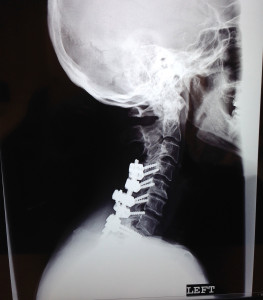 The new normal means that my neck gets tired of holding up my head. Although the average human head only weighs about 10-11 pounds, most days mine feels much heavier than that. It’s difficult to spend hours writing at the computer or reading in a chair, and yet that’s where most of my life is lived these days.
The new normal means that my neck gets tired of holding up my head. Although the average human head only weighs about 10-11 pounds, most days mine feels much heavier than that. It’s difficult to spend hours writing at the computer or reading in a chair, and yet that’s where most of my life is lived these days.
The new normal means that walking on pavement or sidewalks causes pain to my ankle. A casual stroll at sunset is okay. But exercise is confined to the elliptical (thankful I can do that!) and the occasional water workout in a neighbor’s pool (which I love).
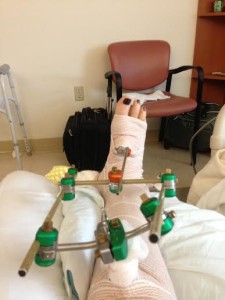 The new normal means that doing things that require a high level of energy—like planning and hosting parties, having company for dinner, being with grandchildren—are exhausting and challenging. But these are the things I love most so I push on.
The new normal means that doing things that require a high level of energy—like planning and hosting parties, having company for dinner, being with grandchildren—are exhausting and challenging. But these are the things I love most so I push on.
The new normal means that I have a higher level of brain fuzz than before the wreck. Being 64 and third generation Alzheimer’s, I’m sure some of this is genetic. But I haven’t recovered the same level of concentration I once had.
The new normal also means that most days I find a way to thank God for these struggles. Yes. The tiredness, aches and pains are there because (1) I am alive and (2) I’m not paralyzed. I hope I never take these realities for granted, although I know I must whenever I complain. My sweet husband bears the brunt of that, since most of the time I manage to put up a happy and healthy front when I’m away from the house. Or even when I’m home and entertaining. But when it’s just the two of us, I’m afraid I often sound grumpy. I’m working on that, because no one should have to live with an ungrateful bitch.
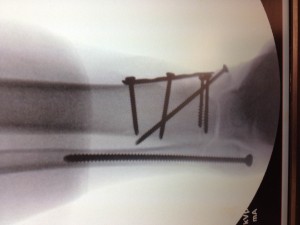 The new normal means that I often try to numb my aches, pain and depression with comfort food. I currently weigh more than I ever have. Most of my pants and jeans are too tight and I’ve bought dresses and tops in larger sizes. From a mental health point of view, this bothers me more than the aches and pains. Issues with food and weight aren’t new in my life. They’re just exacerbated by my other struggles. I know enough about food and nutrition to make better choices, and I hope that I can incorporate those choices into the new normal for my life. One day at a time.
The new normal means that I often try to numb my aches, pain and depression with comfort food. I currently weigh more than I ever have. Most of my pants and jeans are too tight and I’ve bought dresses and tops in larger sizes. From a mental health point of view, this bothers me more than the aches and pains. Issues with food and weight aren’t new in my life. They’re just exacerbated by my other struggles. I know enough about food and nutrition to make better choices, and I hope that I can incorporate those choices into the new normal for my life. One day at a time.
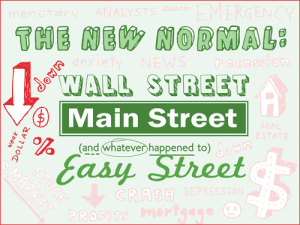 And finally, the new normal is a financial term describing the economic conditions in our country following the recession of 2007-2012. As a people, most of us don’t want to deny ourselves the lifestyle we work hard to provide for ourselves and our families. We don’t like to be disciplined in our consumer habits. And yet the reality is that there are consequences for our actions. We have to live with those consequences and learn to make better choices. This is especially hard for those of us who often buy things in an effort to comfort our suffering. I hope that putting these things in writing will help me embrace this part of my new normal as I move forward.
And finally, the new normal is a financial term describing the economic conditions in our country following the recession of 2007-2012. As a people, most of us don’t want to deny ourselves the lifestyle we work hard to provide for ourselves and our families. We don’t like to be disciplined in our consumer habits. And yet the reality is that there are consequences for our actions. We have to live with those consequences and learn to make better choices. This is especially hard for those of us who often buy things in an effort to comfort our suffering. I hope that putting these things in writing will help me embrace this part of my new normal as I move forward.
I appreciate this one so much, Susan. I also admire your determination to embrace this “new normal” and your willingness to share the struggle. And I thank you and love you for your encouragement.
I can’t help but notice how pretty your hair looks in the photo of your scar. Definitely a new normal!
My goodness, Laura. You’re so sweet. They call scars like mine a “neck zipper” and I hear they are all the rage:-) But seriously, I appreciate the compliment. Thanks for reading.